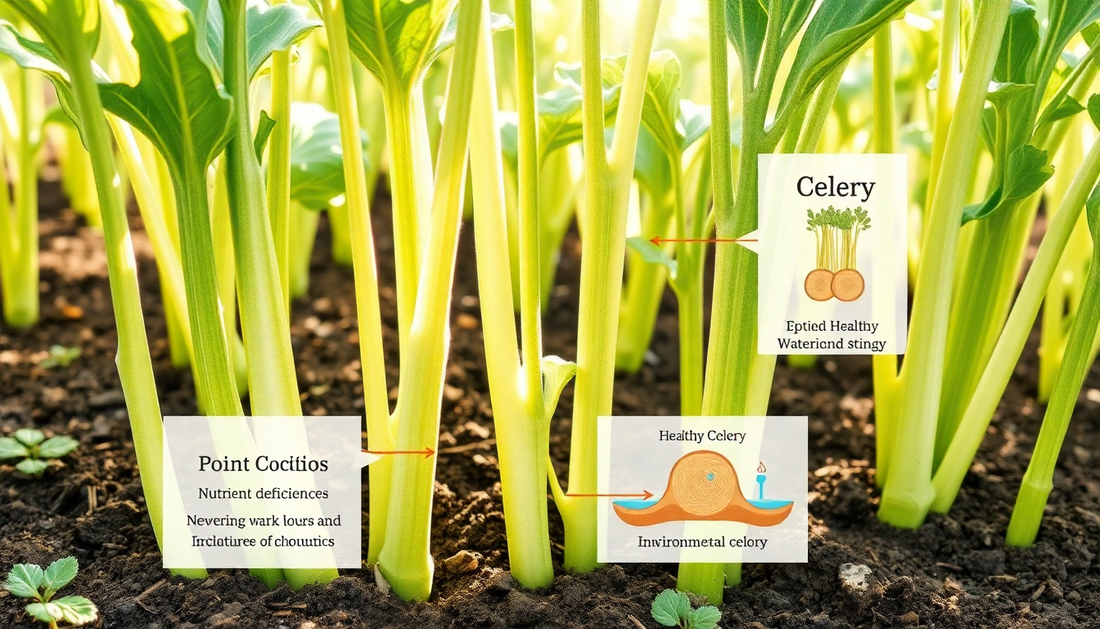
Why Are My Celery Stalks Thin and Stringy?
If you're a gardener who has grown celery, you've likely encountered the frustration of thin, stringy stalks. This common issue can be caused by a variety of factors, from soil conditions to watering practices. In this comprehensive blog post, we'll explore the reasons behind this problem and provide practical solutions to help you grow plump, flavorful celery.
Understanding Celery Growth
Celery (Apium graveolens) is a cool-weather crop that thrives in well-drained, nutrient-rich soil. It's a member of the Apiaceae family, which includes other vegetables like carrots, parsnips, and fennel. Celery is known for its distinctive flavor and crunchy texture, making it a popular ingredient in soups, salads, and various dishes.
The key to growing healthy, thick celery stalks lies in providing the right growing conditions. Celery plants require consistent moisture, ample sunlight, and a balanced nutrient supply to develop their characteristic thick, juicy stalks.
Causes of Thin, Stringy Celery Stalks
There are several common reasons why celery stalks may become thin and stringy. Let's explore the most prevalent causes:
1. Inadequate Soil Fertility
Celery is a heavy feeder, meaning it requires a lot of nutrients to thrive. If the soil is lacking in essential nutrients, such as nitrogen, phosphorus, and potassium, the celery plants will struggle to produce thick, succulent stalks. Instead, they'll focus their energy on producing thin, fibrous growth.
2. Inconsistent Moisture Levels
Celery plants need a consistent supply of moisture to maintain their crisp texture and prevent the stalks from becoming stringy. Fluctuations in soil moisture, either too dry or too wet, can cause the celery to become tough and fibrous.
3. Improper Spacing or Overcrowding
If celery plants are planted too close together, they'll compete for resources, leading to thin, spindly stalks. Adequate spacing between plants is crucial to allow for proper root development and air circulation, which can prevent stringiness.
4. Pest or Disease Infestations
Certain pests, such as aphids or celery leaf miners, can damage the plant's foliage and stunt its growth, resulting in thin, stringy stalks. Additionally, diseases like celery mosaic virus or Septoria leaf spot can also contribute to poor stalk development.
5. Genetic Factors
In some cases, the tendency for thin, stringy celery stalks may be inherent to the specific variety or cultivar you're growing. Some celery varieties are naturally more prone to this issue than others, so it's essential to choose a cultivar that is known for producing thick, juicy stalks.
Strategies for Thick, Flavorful Celery Stalks
Now that we've identified the common causes of thin, stringy celery stalks, let's explore the strategies you can implement to ensure a bountiful and delicious harvest:
1. Improve Soil Fertility
Amend your soil with a balanced, slow-release fertilizer or compost before planting. This will provide a steady supply of nutrients throughout the growing season. Additionally, consider using a water-soluble fertilizer to give your celery plants a nutrient boost during the growing season.
2. Maintain Consistent Soil Moisture
Celery thrives in consistently moist, but not waterlogged, soil. Implement a regular watering schedule, ensuring the soil is kept evenly moist but not saturated. Mulching around the plants can also help retain soil moisture and prevent fluctuations.
3. Provide Adequate Spacing
Follow the recommended spacing guidelines for your celery variety, typically around 12-18 inches between plants. This will allow each plant to develop its root system and foliage without competing for resources.
4. Protect Against Pests and Diseases
Regularly inspect your celery plants for signs of pests or disease, and take appropriate action to address any issues. Use organic pest control methods, such as introducing beneficial insects or applying neem oil, to keep your plants healthy and thriving.
5. Choose the Right Celery Variety
Research and select celery cultivars that are known for producing thick, juicy stalks. Some popular varieties include 'Golden Self-Blanching', 'Utah 52-70', and 'Tall Utah'. These varieties have been bred to minimize the tendency for stringiness.
6. Blanch the Celery Stalks
Blanching, or covering the celery stalks with soil or mulch, can help to reduce bitterness and improve the texture of the stalks. This process blocks sunlight from reaching the lower portions of the celery, resulting in more tender, less stringy growth.
By implementing these strategies, you can overcome the challenge of thin, stringy celery stalks and enjoy a bountiful harvest of flavorful, crunchy celery. Remember, patience and attention to detail are key when it comes to growing exceptional celery.
Conclusion
Thin, stringy celery stalks can be a frustrating problem for gardeners, but with the right approach, you can achieve the thick, juicy celery you desire. By understanding the underlying causes, such as soil fertility, moisture levels, and genetic factors, you can take targeted actions to address the issue. With consistent care and the right growing conditions, you'll be rewarded with a harvest of delicious, crisp celery that will elevate your culinary creations.
Happy gardening!







No comments